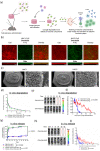Biodegradable scaffolds for enhancing vaccine delivery
- PMID: 38023723
- PMCID: PMC10658593
- DOI: 10.1002/btm2.10591
Biodegradable scaffolds for enhancing vaccine delivery
Abstract
Sustained release of vaccine components is a potential method to boost efficacy compared with traditional bolus injection. Here, we show that a biodegradable hyaluronic acid (HA)-scaffold, termed HA cryogel, mediates sustained antigen and adjuvant release in vivo leading to a durable immune response. Delivery from subcutaneously injected HA cryogels was assessed and a formulation which enhanced the immune response while minimizing the inflammation associated with the foreign body response was identified, termed CpG-OVA-HAC2. Dose escalation studies with CpG-OVA-HAC2 demonstrated that both the antibody and T cell responses were dose-dependent and influenced by the competency of neutrophils to perform oxidative burst. In immunodeficient post-hematopoietic stem cell transplanted mice, immunization with CpG-OVA-HAC2 elicited a strong antibody response, three orders of magnitude higher than dose-matched bolus injection. In a melanoma model, CpG-OVA-HAC2 induced dose-responsive prophylactic protection, slowing the tumor growth rate and enhancing overall survival. Upon rechallenge, none of the mice developed new tumors suggesting the development of robust immunological memory and long-lasting protection against repeat infections. CpG-OVA-HAC2 also enhanced survival in mice with established tumors. The results from this work support the potential for CpG-OVA-HAC2 to enhance vaccine delivery.
Keywords: compounds/materials; drug delivery; immunotherapies; medical devices; tissue engineering.
© 2023 The Authors. Bioengineering & Translational Medicine published by Wiley Periodicals LLC on behalf of American Institute of Chemical Engineers.
Figures






References
-
- Shah NJ, Najibi AJ, Shih TY, et al. A biomaterial‐based vaccine eliciting durable tumour‐specific responses against acute myeloid leukaemia. Nat Biomed Eng. 2020;4:40‐51. - PubMed

